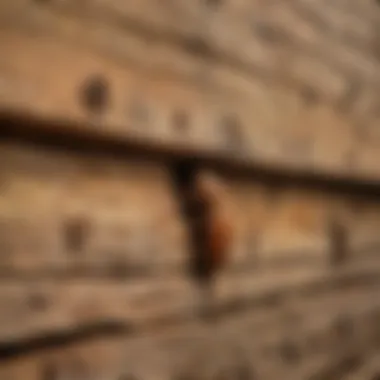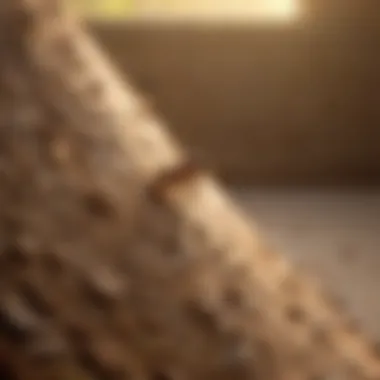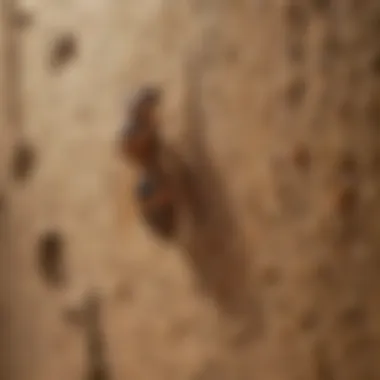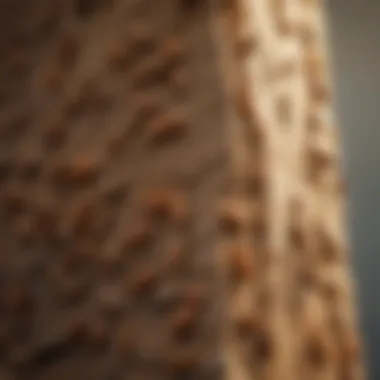Comprehensive Guide to Termite Inspection in Carlsbad


Intro
Termite inspections play a critical role in maintaining the structural integrity of homes, particularly in regions like Carlsbad, where conditions can favor these pests. Understanding the significance of these inspections not only protects property but also contributes to effective pest management strategies. This guide will explore the various facets of termite inspections, including identification, control methods, and more, offering valuable insights for homeowners and pest control professionals alike.
Understanding the Pest
Termites are notorious for their ability to cause extensive damage to wooden structures, and understanding them is crucial for effective management. This section will delve into the identification of termites, as well as their life cycle, establishing a foundation for recognizing signs of an infestation.
Identification
Termites may often be confused with ants due to their similar appearance. However, a few key characteristics set them apart. Termites typically have a straight antenna, a broad waist, and a body that is generally uniform in width. Two main types of termites are prevalent in Carlsbad: subterranean and drywood. Subterranean termites build their colonies underground, while drywood termites nest within the wood itself. Recognizing these types is important for determining treatment approaches.
Life Cycle
The life cycle of termites consists of four main stages: egg, nymph, adult, and reproductive. Eggs hatch into nymphs, which then undergo several molts before reaching maturity. The entire process can take several months to years, depending on the species and environmental conditions. It is vital to understand this cycle, as early detection during the nymph or egg stage can substantially mitigate the extent of a possible infestation.
Pest Prevention Strategies
Proactive measures can significantly diminish the risk of termite infestations. This section will focus on environmental modifications and physical barriers that homeowners can implement.
Environment Modification
Altering the surroundings of a home can deter termites. Keeping woodpiles away from structures, ensuring proper drainage, and fixing leaks are essential steps. The goal is to reduce moisture and accessibility to food sources, making homes less attractive to termites.
Physical Barriers
Installing physical barriers during construction or renovation can also provide long-term protection. Steel mesh, sand barriers, and concrete are effective against subterranean termites. Homeowners should consider consulting with pest control experts to determine the best options tailored to their properties.
Control Methods
When prevention measures fall short, it is important to have reliable control methods in place. This section covers both chemical and biological control solutions, highlighting their effectiveness and application.
Chemical Control
Pesticides remain one of the most common methods for termite control. Subterranean termites, for instance, might require liquid termiticides injected into the soil. Brands like Termidor and Spectracide offer various formulations. Homeowners should follow application instructions carefully to ensure safety and efficacy.
Biological Control
Moving towards more eco-friendly options, biological control methods are gaining traction. These methods include introducing nematodes, microscopic worms that attack termite larvae, or using beneficial microorganisms. Such approaches prioritize environmental health while still targeting the termite population effectively.
Key Takeaway: Adequate knowledge about termite behavior, coupled with preventive strategies and control methods, empowers homeowners to safeguard their properties.
This guide serves as a primer for those looking to understand the intricacies of termite inspection and management in Carlsbad. Equipped with this knowledge, homeowners can make informed decisions about protecting their homes against termite threats.
Understanding Termites
Understanding termites is crucial for homeowners and property managers, especially in regions like Carlsbad, where these pests can cause serious damage to structures. Termites are often called silent destroyers because they can chew through wood, flooring, and even wallpaper without anyone noticing until significant damage has occurred. Recognizing their biology and behavior is the first step towards effective management.
Biology of Termites
Life Cycle of Termites
The life cycle of termites begins with the egg stage. A termite colony can produce thousands of eggs daily. Eggs hatch into larvae, which will mature into worker, soldier, or reproductive adults. This cycle contributes to the rapid growth of infestation levels. Understanding this life cycle is essential for homeowners. Recognizing stages can help determine the level of an infestation and the best time for treatment. Moreover, knowing how quickly termites can reproduce helps prioritize inspection and treatment.
Types of Termites
There are several types of termites, which can affect how a infestation is managed. The three primary classifications are subterranean, drywood, and dampwood termites. Subterranean termites live underground. They build tunnels and often travel through mud tubes. Drywood termites, on the other hand, can infest wood directly, requiring no contact with soil. Dampwood termites thrive in decaying wood and moist conditions. Understanding the type of termite is beneficial. Each type comes with unique behaviors and needs different treatment approaches to eliminate them effectively.
Termite Behavior
Termite behavior varies greatly by species but generally includes feeding habits and colony formation. They work together in colonies, often creating extensive networks within structures. This behavior demonstrates their survival strategy, which directly impacts their rate of damage. Recognizing the signs of termite behavior, such as swarming during spring, can alert homeowners to potential infestations before significant damage occurs. Highlighting these behaviors can assist in crafting more accurate inspection and treatment plans.


Signs of Infestation
Visual Indicators
Visual indicators of a termite infestation include mud tubes on walls and hollowed wood. These signs can be a clear indication of active colonies in proximity. Spotting these early can help prevent further damage. Noticing these indicators can lead to timely inspections or treatments. This proactive approach can save considerable repair costs down the line.
Noises and Smells
Noises and smells from an infestation can be subtle yet alarming. Homeowners might hear a clicking or munching sound if they listen closely, particularly in walls or wooden structures. Furthermore, a musty odor can sometimes signal a termite presence. These auditory and olfactory clues are critical. They can indicate deeper infestations that need immediate attention. Understanding these signs is essential for initiating timely inspections and potential treatments.
Damaged Wood
An essential aspect of identifying termites is recognizing damaged wood. Termites can cause significant destruction to wooden structures, making them feel hollow or brittle to the touch. Visible signs might include small holes or frass, which is the poop left by termites. If homeowners pay close attention and inspect their wooden structures periodically, they can catch potential infestations early. Notably, inspecting damaged wood is paramount in preserving the integrity of a property.
Importance of Termite Inspection
Termite inspection is a critical element in effective pest management, especially in areas such as Carlsbad where termite activity can be prevalent. Understanding the various aspects of termite inspections helps homeowners avoid costly damages and maintain the integrity of their properties. Specifically, we will explore the preventive measures associated with termite inspections and the legal and insurance considerations that underscore their importance.
Preventive Measures
Cost Efficiency
The financial implications of termite damage can be staggering. Fixing structural issues after an infestation is often much more costly than proactive inspection and treatment. Investing in regular termite inspections offers significant long-term savings. Homeowners can catch problems early before they escalate into major repair bills. The key characteristic here is that proactive measures save money overall. Regular inspections can be seen as an upfront cost that prevents far greater expenditures in the future.
Property Value Preservation
Termites can devalue a property drastically if left unchecked. Regular inspections not only protect the current value of a property but also enhance its resale value. If a home has a history of termite inspections and treatments, potential buyers are more likely to feel comfortable making an offer. Therefore, the unique feature of property value preservation emphasizes the financial sense behind inspections. Maintaining the condition of your home is a significant selling point.
Health Hazards
While termites primarily cause structural damage, they can also lead to health-related issues. The moisture from termite infestations can foster mold growth, which poses serious respiratory risks. Regular inspections can uncover these issues before they become health hazards. This makes addressing health risks a crucial part of termite management. The unique element here is the link between pest control and household health, making inspections not only a financial necessity but a health safeguard as well.
Legal and Insurance Considerations
Homeowners Insurance
Most homeowners insurance policies do not cover termite damage, making inspections even more important. If an infestation occurs, the burden falls entirely on the homeowner for repairs. Therefore, understanding the terms of Homeowners Insurance is vital for property owners. Regular inspections can potentially help in claiming other insurance benefits related to home maintenance. Knowing the limitations of coverage drives the point home that being proactive pays off.
Local Regulations
Community guidelines may dictate certain standards for pest management. Understanding these local regulations is essential for compliance and can prevent legal troubles down the road. Local authorities often emphasize the need for inspections in high-risk areas. This makes awareness of local regulations a key characteristic of termite inspections, ensuring that homeowners adhere to mandated preventive measures.
Required Documentation
Keeping detailed records of inspections can also be important for future reference. Having verified documentation is crucial when dealing with real estate transactions or insurance claims. This documentation helps in demonstrating that due diligence was performed in maintaining the property. A well-maintained history of pest control enhances credibility, making required documentation an advantageous aspect in property management.
Effective termite inspections play a crucial role in sustaining property value and ensuring health safety.
Methods of Termite Inspection
Termite inspection is crucial for maintaining a safe and sound home environment. Understanding the various methods of termite inspection allows homeowners to detect potential infestations early and take appropriate actions. Various methods have specific strengths and weaknesses. It is important to consider these when planning inspections to assure the effectiveness of pest management strategies.
Visual Inspection Techniques
External Examination
External examination focuses on looking for signs of termite activity outside the home. It includes searching for mud tubes, wood damage, and swarming signs in the perimeter of a property. One key characteristic of this method is its accessibility. Homeowners can conduct this inspection themselves, potentially saving on costs. A unique feature of external examination is the ability to identify potential entry points for termites before they enter the home. However, while useful, this method may miss issues occurring internally. It should be combined with other techniques for comprehensive results.
Internal Assessment
Internal assessment involves a detailed inspection of the interior spaces of a building. Evaluating areas like basements, attics, and crawl spaces is critical. The main characteristic of internal assessment is that it reveals signs of infestation often hidden from plain sight. Homeowners can benefit from this method as it allows a look into critical areas where termites might cause significant damage. Nevertheless, it requires a keen eye for detail and sometimes specific tools, making it slightly more complex than external examination.


Moisture Detection
Moisture detection targets areas at risk of termite infestation due to high humidity. Termites are attracted to moisture-laden wood, therefore, measuring moisture levels can prevent infestations. A notable key characteristic is that it relies on specialized tools like moisture meters. This method is beneficial as it identifies conditions that may invite termite colonies. However, it might require investment in equipment, and sometimes results may need a professional’s interpretation to ensure accuracy.
Advanced Detection Tools
Tapping and Listening Devices
Tapping and listening devices allow inspectors to detect hollow sounds in wood. This approach is valuable in identifying potentially infested areas. Its central feature is the reliance on sound, which offers a non-invasive method of detection. This method is seen as beneficial as it allows for real-time evaluation of wood integrity. Nevertheless, it may take some skill to interpret results accurately, making it less effective for inexperienced homeowners.
Thermal Imaging Cameras
Thermal imaging cameras are innovative tools that visualize temperature variations in walls and ceilings. This method does not require direct contact, offering an efficient way to locate moisture pockets where termites could thrive. Its key characteristic is the ability to capture images that reveal concealed termite activity. This method is popular due to its non-invasive nature. However, the technology can be expensive, posing a question for cost-effectiveness in DIY inspections.
Moisture Meters
Moisture meters measure the moisture content in wood and other materials to identify potential problem areas. They are an important tool because termites are more likely to infest damp wood. The key characteristic of moisture meters is their accuracy in quantifying moisture levels. This technology appeals to homeowners looking for precision in their inspections. However, misinterpretation of moisture levels can lead to unnecessary concerns, thus requiring careful analysis.
Professional Inspection Services
Choosing a Qualified Inspector
Choosing a qualified inspector is a fundamental aspect of effective termite management. The right expert brings knowledge and experience to the inspection, which significantly increases the likelihood of identifying infestations. A key characteristic is verifying credentials and past performance. Selecting the right professional can be beneficial, ensuring thorough and accurate results. However, costs vary widely, which is something homeowners should carefully consider when making their decision.
What to Expect During an Inspection
Understanding what to expect during an inspection is important for homeowners. This involves knowing the areas that will be examined and what tools may be used. A key characteristic of professional inspections is that they will generally provide a comprehensive assessment of both exterior and interior spaces. This understanding creates a realistic picture of the inspection process. However, some homeowners may find the process daunting if they do not know what to anticipate.
Post-Inspection Reports
Post-inspection reports summarize the findings of the inspection, detailing the extent of any infestations or potential problems. A key benefit of these reports lies in their documentation of necessary steps for treatment and prevention. Such reports serve as valuable references for homeowners to address issues promptly. However, understanding technical jargon can be a challenge, necessitating clear communication from inspectors.
DIY Termite Inspection
Performing a DIY termite inspection can be both empowering and risky for homeowners. This process allows individuals to take charge of their property, potentially saving on costs associated with professional services. However, it is essential to do so with caution and a proper understanding of what to look for. Knowing the signs of termite activity and having the right tools can aid significantly in identifying a problem before it escalates.
Tools and Techniques
Essential Tools for Homeowners
Homeowners looking to conduct their own termite inspections should equip themselves with several basic tools. The most important tools include a flashlight, a screwdriver, and a moisture meter. The flashlight illuminates dark areas where termites often hide. A screwdriver helps in probing wood for signs of damage, while a moisture meter identifies damp areas that attract termites. These tools are beneficial as they allow for an thorough examination of both the interior and exterior of the structure. Each tool has a unique function that contributes to uncovering potential infestations early, ultimately protecting the property from serious damage.
Step-by-Step Guide
Creating a step-by-step guide is crucial for homeowners who wish to inspect for termites effectively. Start by examining the outside of the house, checking the foundation and any wood structures. Next, move to the interior, focusing on areas near plumbing and moisture sources, such as bathrooms and kitchens. Look for mud tubes, discarded wings, and frass, which indicate termite presence. Writing down observations helps map out problem areas for future reference. This structured approach supports the goal of being thorough and prevents overlooking critical signs of infestation.
Common Pitfalls
Many homeowners may not be aware of common pitfalls in DIY termite inspections. A frequent mistake is neglecting to check hidden areas, such as attics, crawl spaces, and behind appliances. Another common error is rushing through the inspection without taking enough time to look for subtle signs of termite activity. Such oversights can lead to serious damage down the line. Understanding these pitfalls allows homeowners to be more vigilant, emphasizing the need for a comprehensive approach to the inspection process.
When to Seek Professional Help
Despite the merits of DIY inspection, there are situations when professional help is necessary. Recognizing when it is time to call experts can prevent worsening infestations.
Signs of Heavy Infestation
Indicators of heavy infestation include noticeable structural damage and large numbers of mud tubes. Homeowners should be cautious when observing these signs, as they often suggest a significant termite presence that may exceed the homeowner's ability to manage alone. Not addressing these indicators promptly can lead to extensive and costly repairs.
Specialized Expertise Required
In some cases, the issue may require specialized expertise that goes beyond basic DIY skills. Termite control professionals possess specific training in identifying and treating infestations safely and effectively. Their experience makes them valuable in complicated situations, particularly when determining the source of the infestation.


Safety Considerations
Safety is a crucial aspect to consider in termite detection. Some homeowners may feel comfortable working in confined spaces or using various tools. However, entering attics or crawl spaces can pose risks of falling, encountering hazardous materials, or even injuring oneself with tools. It is vital for individuals to be self-aware and assess whether they can carry out the inspection safely. If there is any uncertainty, hiring a professional may be the best course of action to ensure safety as well as effective pest control.
Eco-Friendly Pest Management Solutions
Effective pest management practices have evolved over recent years, particularly with regards to termites. Eco-friendly pest management solutions serve not only to control termite populations but also to minimize environmental impact. As homeowners become more aware of their ecological footprint, many are seeking sustainable alternatives to traditional chemical treatments. The benefits of these solutions include protecting beneficial insects, reducing toxicity in home environments, and promoting a healthier living space.
Natural Treatment Options
Boric Acid
Boric acid is a naturally occurring compound that has become popular in termite treatment strategies. It acts as a stomach poison to termites when ingested and disrupts their digestive systems. Boric acid is favored because it is less harmful to humans and pets when used properly. One unique feature of boric acid is its ability to repel termites as well, offering a dual action against these pests. However, effectiveness depends on proper application and weather conditions, which are its main drawbacks.
Beneficial Nematodes
Beneficial nematodes are microscopic worms that can help in controlling termite populations. They seek out pests in the soil, including termite larvae, and release bacteria that kill the host. This option is especially beneficial due to its specificity; nematodes target pests without harming beneficial insects. While this method is low-risk for the environment, the success of nematodes can vary based on soil conditions and the species used.
Essential Oils
Essential oils, such as thymol and clove oil, have gained attention for their potential as natural repellents against termites. These oils can disrupt termite behavior and deter them from infesting an area. Homeowners appreciate essential oils for their pleasant scent and non-toxic nature. However, the challenge lies in the concentration required for effectiveness, which can sometimes make them less practical for serious infestations.
Integrated Pest Management Practices
Integrated pest management (IPM) combines multiple strategies to foster sustainable pest control. One main advantage is that it minimizes the reliance on chemical treatments. Homeowners can promote long-term solutions by focusing on collaborative techniques.
Prevention Strategies
Prevention strategies are critical in controlling termite problems before they start. Effective methods include regular inspections, eliminating moisture sources, and maintaining proper landscaping. The key characteristic of prevention strategies lies in their proactive nature, allowing homeowners to address potential termite attractants. However, these methods require ongoing effort and awareness, which can be challenging for busy households.
Monitoring Techniques
Monitoring techniques help homeowners to detect early signs of infestation. Using tools like moisture meters and visual inspections, monitoring becomes an essential part of pest management. Its key feature is the provision of timely information about potential pest presence. While these methods can be effective, they often necessitate some training or knowledge about pest behavior, affecting their accessibility for some homeowners.
Evaluation of Treatment Efficacy
Evaluating treatment efficacy is crucial to determine the success of pest management efforts. Homeowners should consistently assess the effectiveness of both natural and traditional treatments. This concept is vital because it helps adjust strategies accordingly to ensure optimal results. The unique feature of this practice is that it emphasizes continuous improvement, but it can require additional time and resources, which might be a challenge for some.
Eco-friendly solutions not only benefit the environment but can also enhance the overall quality of your home life.
Culmination
In the context of termite inspection, the conclusion serves as a critical component summarizing the comprehensive insights presented in the article. This segment emphasizes the importance of understanding the lifecycle, behavior, and potential damages caused by termites. It highlights the need for regular inspections as a preventive measure to protect property value and ensure a safe living environment.
Notably, early detection of termite infestations not only minimizes extensive damage but also reduces the costs associated with severe treatments. Whatever method you choose—be it professional inspections or DIY assessments—understanding the signs and implications of termite presence cannot be overstated. This understanding fosters a proactive stance against these pests, ensuring that interventions can be timely and effective.
It is vital for homeowners in Carlsbad to grasp the nuances of their local regulations regarding termite inspections. Compliance with any legal stipulations is essential in safeguarding one's investment in property and maintaining a healthy habitat.
Ultimately, knowledge is key. Having a solid grasp of termite behaviors and preventive measures can empower homeowners to take action.
Recap of Key Points
A summary of the most important aspects concerning termite inspection includes:
- Understanding Termites: Knowledge of termite biology helps in recognizing types and behaviors relevant to infestations.
- Importance of Inspections: Regular inspections can uncover signs of infestations early, leading to timely interventions.
- Methods of Inspection: Familiarity with visual and advanced inspection techniques supports effective pest management choices.
- DIY vs. Professional Help: Recognizing the right moments to rely on professional services ensures thorough evaluations.
- Eco-Friendly Solutions: Embracing sustainable pest management aligns with modern values and contributes to environmental wellness.
Together, these elements form a holistic view of termite inspection, which is crucial in ensuring long-term home protection.
Final Thoughts on Termite Prevention
As the gradual impact of termites can be devastating, prevention remains the most effective strategy for homeowners. Continuous education about termite behavior helps in maintaining vigilance. Homeowners should regularly check for indicators of termite activity, including soft sounds from within walls and unexplained repair needs.
Several best practices can be adopted to minimize risks:
- Regular Inspections: Schedule annual checks, or bi-annual in areas known for high termite activity.
- Moisture Management: Keep the home dry; eliminate standing water around foundations.
- Proper Landscaping: Ensure that soil isn’t directly in contact with wood components of the house.
Setting a proactive maintenance plan can significantly help in reducing the chances of infestations. The pursuit of effective pest management is an ongoing journey, one that requires diligence and informed decision-making. Investing time in prevention not only safeguards the home but also enhances the overall quality of life.







